Home > Directory Home > Drawing Lessons > Drawing for Beginners >How to Draw Inanimate Objects and Items
How to Draw INANIMATE OBJECTS AND ITEMS
|
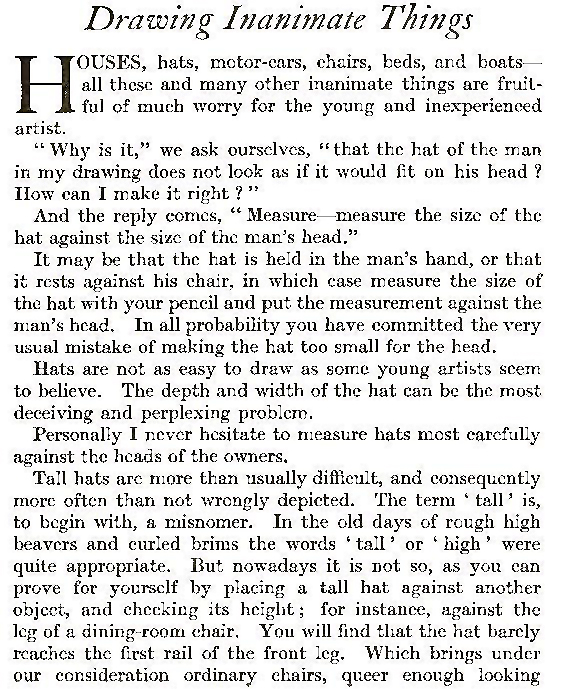
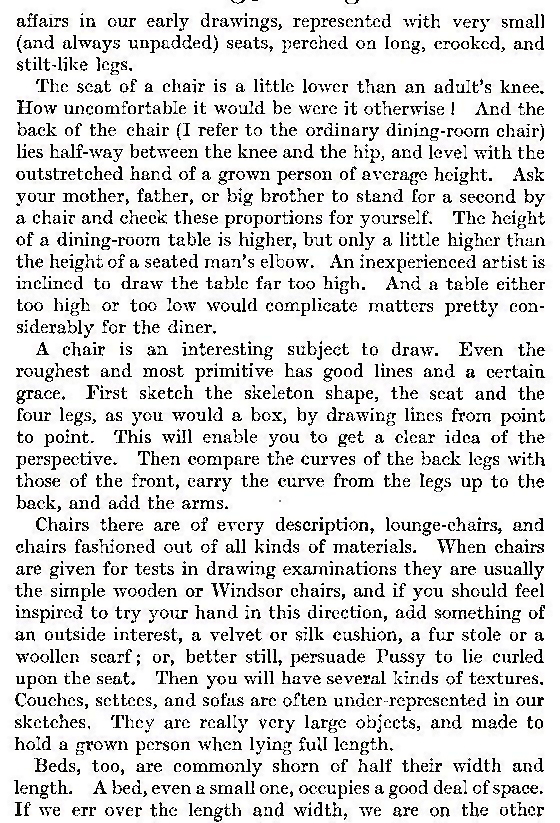
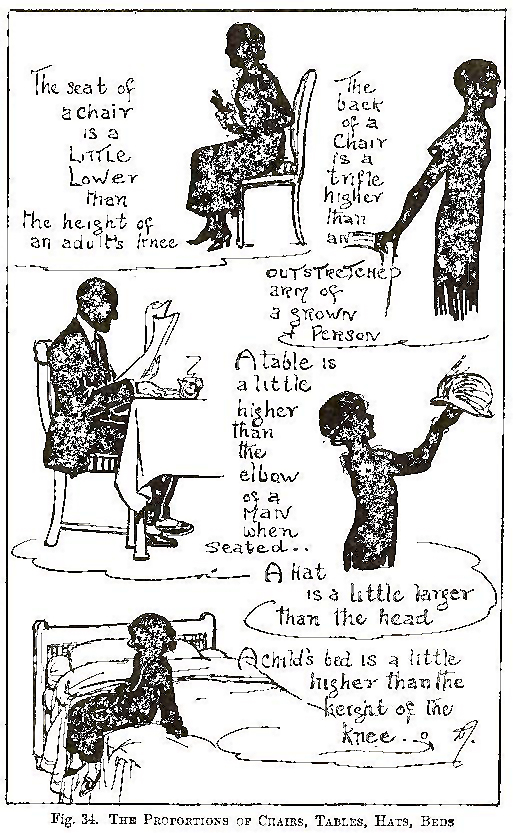
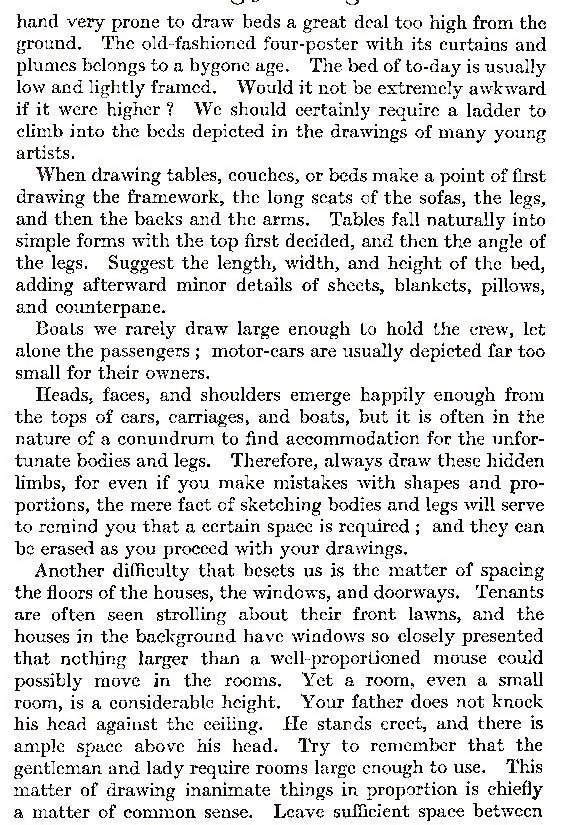
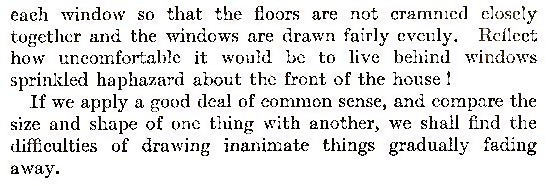
GO BACK TO THE HOME PAGE FOR TUTORIALS FOR BEGINNING ARTISTS
[The above words are pictures of text, below is the actual text if you need to copy a paragraph or two]
Drawing Inanimate Objects & Things
Houses, hats, motor-cars, chairs, beds, and boats—all these and many other inanimate things are fruitful of much worry for the young and inexperienced artist.
"Why is it," we ask ourselves" that the hat of the man in my drawing does not look as if it would fit on his head ? How can I make it right?"
And the reply comes, " Measure—measure the size of the hat against the size of the man's head."
It may be that the hat is held in the man's hand, or that it rests against his chair, in which case measure the size of the hat with your pencil and put the measurement against the man's head. In all probability you have committed the very usual mistake of making the hat too small for the head.
Hats are not as easy to draw as some young artists seem to believe. The depth and width of the hat can be the most deceiving and perplexing problem.
Personally I never hesitate to measure hats most carefully against the heads of the owners.
Tall hats are more than usually difficult, and consequently more often than not wrongly depicted. The term ' tall ' is, to begin with, a misnomer. In the old days of rough high beavers and curled brims the words ' tall ' or ' high ' were quite appropriate.
But nowadays it is not so, as you can prove for yourself by placing a tall hat against another object, and checking its height ; for instance, against the leg of a dining-room chair. You will find that the hat barely reaches the first rail of the front leg.
Which brings under our consideration ordinary chairs, queer enough looking affairs in our early drawings, represented with very small (and always unpadded) seats, perched on long, crooked, and stilt-like legs.
The seat of a chair is a little lower than an adult's knee. How uncomfortable it would be were it otherwise ! And the back of the chair (I refer to the ordinary dining-room chair) lies half-way between the knee and the hip, and level with the outstretched hand of a grown person of average height. Ask your mother, father, or big brother to stand for a second by a chair and check these proportions for yourself. The height of a dining-room table is higher, but only a little higher than the height of a seated man's elbow. An inexperienced artist is inclined to draw the table far too high. And a table either too high or too low would complicate matters pretty considerably for the diner.
A chair is an interesting subject to draw. Even the roughest and most primitive has good lines and a certain grace. First sketch the skeleton shape, the seat and the four legs, as you would a box, by drawing lines from point to point. This will enable you to get a clear idea of the perspective. Then compare the curves of the back legs with those of the front, carry the curve from the legs up to the back, and add the arms.
Chairs there are of every description, lounge-chairs, and chairs fashioned out of all kinds of materials. When chairs are given for tests in drawing examinations they are usually the simple wooden or Windsor chairs, and if you should feel inspired to try your hand in this direction, add something of an outside interest, a velvet or silk cushion, a fur stole or a woollen scarf ; or, better still, persuade Pussy to lie curled upon the seat. Then you will have several kinds of textures. Couches, settees, and sofas are often under-represented in our sketches. They are really very large objects, and made to hold a grown person when lying full length.
Fig. 34. THE PROPORTIONS OF CHAIRS, TABLES, HATS, BEDS
Beds, too, are commonly shorn of half their width and length. A bed, even a small one, occupies a good deal of space. If we err over the length and width, we are on the other hand very prone to draw beds a great deal too high from the ground. The old-fashioned four-poster with its curtains and plumes belongs to a bygone age. The bed of to-day is usually low and lightly framed. Would it not be extremely awkward if it were higher ? We should certainly require a ladder to climb into the beds depicted in the drawings of many young artists.
When drawing tables, couches, or beds make a point of first drawing the framework, the long seats of the sofas, the legs, and then the backs and the arms. Tables fall naturally into simple forms with the top first decided, and then the angle of the legs.
Suggest the length, width, and height of the bed, adding afterward minor details of sheets, blankets, pillows, and counterpane.
Boats we rarely draw large enough to hold the crew, let alone the passengers ; motor-cars are usually depicted far too small for their owners.
Heads, faces, and shoulders emerge happily enough from the tops of cars, carriages, and boats, but it is often in the nature of a conundrum to find accommodation for the unfortunate bodies and legs. Therefore, always draw these hidden limbs, for even if you make mistakes with shapes and proportions, the mere fact of sketching bodies and legs will serve to remind you that a certain space is required ; and they can be erased as you proceed with your drawings.
Another difficulty that besets us is the matter of spacing the floors of the houses, the windows, and doorways. Tenants are often seen strolling about their front lawns, and the houses in the background have windows so closely presented that nothing larger than a well-proportioned mouse could possibly move in the rooms. Yet a room, even a small room, is a considerable height.
Your father does not knock his head against the ceiling. He stands erect, and there is ample space above his head. Try to remember that the gentleman and lady require rooms large enough to use. This matter of drawing inanimate things in proportion is chiefly a matter of common sense. Leave sufficient space between each window so that the floors are not crammed closely together and the windows are drawn fairly evenly. Reflect how uncomfortable it would be to live behind windows sprinkled haphazard about the front of the house!
If we apply a good deal of common sense, and compare the size and shape of one thing with another, we shall find the difficulties of drawing inanimate things gradually fading away.
Privacy Policy .... Contact Us




